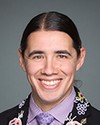Thank you again for that question. It's a very important one.
I acknowledge that the system is complex and is not necessarily the easiest to manoeuvre through, whether from a client perspective or at times even from a staff perspective.
As you know, we've made a significant investment in order to hire about 400 new employees directly in the field and in the service delivery area. We have developed a very robust national orientation training program that all of our new field staff have gone through—and will be going through, if they are very recent hires. Part of it is certainly explanation of policy and of benefits, and it includes explanation of systems.
As well, we will be rolling that orientation out to all of our existing staff to make sure that everybody is at the same level of understanding. Even more so, for example, in my area in policy, the training and orientation will also be offered to staff in other areas of the organization.
More specifically to your point, we also just completed a service delivery review. One outcome of that service delivery review acknowledged that communication needs to be more assured in terms of the way we communicate, from a functional direction perspective, with the field. As well, there needs to be a reduction of complexity, in the numbers of policies, of business processes; it ties back even to the legislative authorities that we have.
How can we best simplify that work going forward? We have already reduced our policies by more than 200 in the last few years. We are also looking, as an example, through what we're doing with the budget implementation act, putting in this waiver whereby, if we already have all of the information on file, we would be able to make a decision without having to have contact directly with the veteran to get further information. We can then also look at what other benefits they would be eligible for and make decisions on those. That should reduce the, as you said, unfortunate need for the veteran to be constantly going back and forth and possibly even requesting reviews and appeals.
It's certainly something we're very aware of through the training, orientation, and even our service delivery review action plan. We are looking actively at moving forward.





